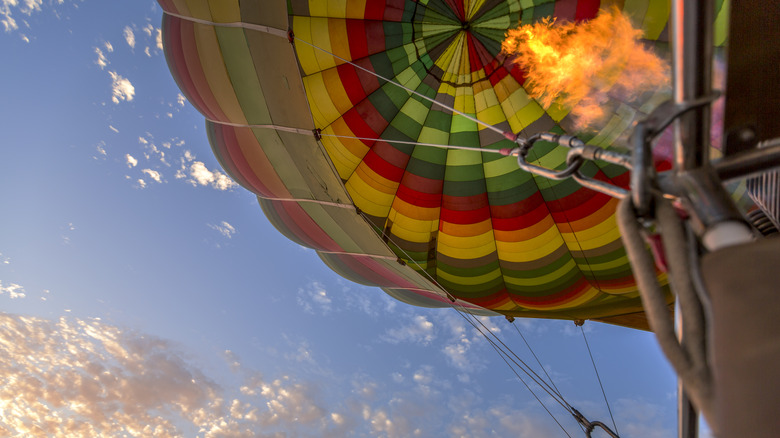The Real Reason Hot Air Balloons Fly So Low
Hot air balloons offer a whimsical and leisurely way to take in the stunning landscapes of our planet. They are also normally totally safe — however, flying too high can potentially make you ill or put you in the way of some serious hazards.
The very first hot air balloon flight was the seemingly mad invention of cocky French scientist Pilatre De Rozier way back in 1783 — whose balloon crashed on the first attempt. In 1785 Rozier died attempting to cross the English Channel in a makeshift balloon. Two centuries later, there is a standard set of safety measures most balloonists follow to prevent similar disasters from occurring. These include rules regarding the maximum height a balloon can safely float at.
Although, to date, the world record holder for the highest hot balloon flight, Vijaypat Singhania reached almost 70,000 feet, scraping the very edge of space, in general, most balloons drift much lower. A normal balloon will typically stay at a measly 1,000 to 3,000 feet above the Earth, which for context is much too low to fly safely over taller mountain ranges such as the European Alps. That said, many hot air balloons do go well over these heights to appreciate particularly beautiful scenery — but only when properly equipped to ensure an enjoyable and terror-free ride.
Height hazards
In our modern age, balloons must share the heavens with aircraft such as commercial jets and helicopters. Different craft take up different parts of our sky at different times, and to help direct the myriad of flying objects whizzing over our heads, airspace is graded from A to E — with A being the highest altitude level. Below this is G-class airspace — aka uncontrolled airspace, where most balloons remain.
At higher levels, any form of airborne craft requires a device called a Mode S Transponder, something balloons don't normally have (via Seattle Ballooning). This equipment helps air traffic control to locate aircraft and prevents them from smashing into each other. Balloons flying at higher heights also potentially need a whole bunch of safety equipment, such as two-way radios in order to operate safely and they should obtain permission before attempting to reach usual heights. There are still some planes flying around in uncontrolled airspace as well, but the lack of cloud cover increases visibility and makes it less likely that a plane will accidentally suck humans into its engines like unfortunate birds.
Rules aside, it is pretty hard for a normal air balloon to safely get over 3,000 feet anyway. Air balloons work by creating hot air which is lighter than the cold air around it; to keep the balloon rising the pilot needs to keep heating it. This means there is an absolute limit to how high a craft can possibly go before the balloon dangerously overheats and comes crashing down.
The sky's the limit
Unless you are comfortably seated in a temperature-controlled aircraft cabin, the higher you climb the more hazardous conditions get for human beings. The increasingly thin air, for example, can become a pretty serious issue. Birds who fly at greater altitudes require special anatomy in order to take in enough oxygen — and we just don't have that kind of luxury.
Just like scaling a mountain, reaching heights of over 3,000 feet can induce a risk of altitude sickness that is potentially hazardous when you need to stay sharp enough to get back down. Those embarking on flights at unusually high altitudes must take oxygen with them, just like a mountain climber. Bad altitude sickness can result in dizzy spells, vomiting, confusion, and even loss of consciousness or death.
Another real hazard for balloons flying at higher heights is simply the weather. Balloons are very reliant on clear and calm weather conditions anyway, but at higher heights, the chances of wild and windy conditions are much greater. The danger, as well as the potentially miserable experience for passengers, mean that only the most well-equipped and intrepid travelers venture high up into the stratosphere.


